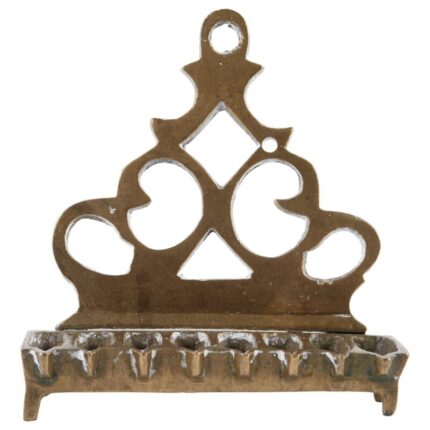Brass Hanukkah lamp Menorah, Poland, circa 1810.
Cast in Bench form, on four feet. The backplate is cast and pierced featuring scrollwork.
This lamp was made by the technique known as “sand casting”. This process begins with a wooden mold that was carved out to create negative space, which in turn is used to make the inverse form or shape to be used for the casting of metal. The mold is pressed into fine sand mixed with clay, then removed, and molten brass poured into the impression. When a mold wears out, a casting from that mold is often used as the mold for the next generation. Those later lamps will have less detail than their older counterparts, and will be one to two percent smaller in size.
In the book “Masterpieces of Jewish Art: Bronze”, author Alexander Kantsedikas states: “22 percent of the Jewish males in Galicia were engaged in different types of crafts in 1820-1827, that is, the period to which the majority of the surviving bronze and copper artifacts date in Western Ukraine. Half a century later the figure grew to 26.2 percent, while the corresponding figure among non-Jews was 2.2 percent”.
Cast in Bench form, on four feet. The backplate is cast and pierced featuring scrollwork.
This lamp was made by the technique known as “sand casting”. This process begins with a wooden mold that was carved out to create negative space, which in turn is used to make the inverse form or shape to be used for the casting of metal. The mold is pressed into fine sand mixed with clay, then removed, and molten brass poured into the impression. When a mold wears out, a casting from that mold is often used as the mold for the next generation. Those later lamps will have less detail than their older counterparts, and will be one to two percent smaller in size.
In the book “Masterpieces of Jewish Art: Bronze”, author Alexander Kantsedikas states: “22 percent of the Jewish males in Galicia were engaged in different types of crafts in 1820-1827, that is, the period to which the majority of the surviving bronze and copper artifacts date in Western Ukraine. Half a century later the figure grew to 26.2 percent, while the corresponding figure among non-Jews was 2.2 percent”.
-
Dimensions:Height: 5.12 in (13 cm)Width: 4.34 in (11 cm)Depth: 1.58 in (4 cm)
-
Materials and Techniques:BrassCast
-
Place of Origin:Poland
-
Period:Early 19th Century
-
Date of Manufacture:circa 1810
-
Condition:Good
-
Seller Location:New York, NY
-
Reference Number:Seller: LU5281219345611
Reviews (0)






































Reviews
There are no reviews yet.